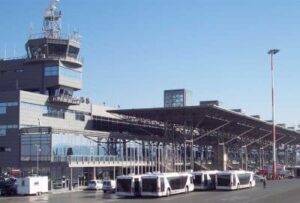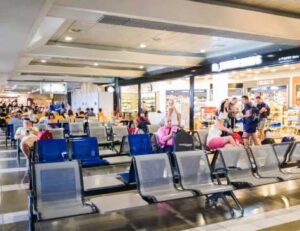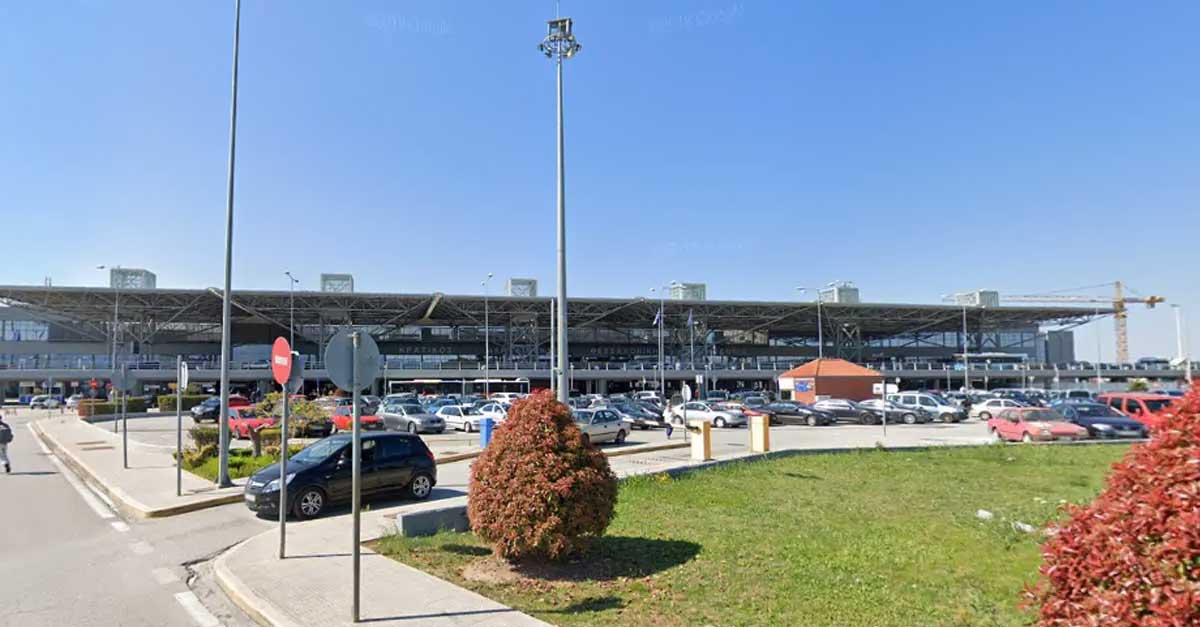Πληροφορίες Αεροδρομίου Θεσσαλονίκης

Η πόλη προσελκύει εκατοντάδες χιλιάδες επισκέπτες ετησίως και φημίζεται για τις βυζαντινές εκκλησίες, το εμπορικό κέντρο, τα καφέ μπαρ και τη νυχτερινή ζωή. Άρχισε να λειτουργεί ως πολιτικός αερολιμένας το 1948. Καθ ‘όλη τη δεκαετία του 1950 τα κτίρια και οι εγκαταστάσεις του αεροδρομίου βελτιώθηκαν και επεκτάθηκαν και το 1965 κατασκευάστηκε το τρέχον κτίριο τερματικών και αυτό επεκτάθηκε με έναν δεύτερο όροφο που προστέθηκε το 1973.
Ο τερματικός σταθμός επεκτάθηκε περαιτέρω στο αρχές της δεκαετίας του 1990 και πάλι στις αρχές της δεκαετίας του 2000. Σήμερα, ο τερματικός σταθμός έχει συνολική επιφάνεια 340.000 τετραγωνικά πόδια σε τρία επίπεδα και διαθέτει μια νέα διεθνή περιοχή αναχωρήσεων, μια νέα αίθουσα check-in, αίθουσες αναμονής και διοικητικά γραφεία για τις αεροπορικές εταιρείες.
Τέλος, άνοιξε μια νέα παράλληλη τροχιά για έναν από τους διαδρόμους και κατά τη διάρκεια του 2004-6 ολοκληρώθηκε μια νέα διασταύρωση αυτοκινητόδρομου στο επίπεδο της εισόδου αναχωρήσεων του τερματικού σταθμού. Το αεροδρόμιο διαθέτει δύο διαδρόμους και δύο τροχοδρόμους με 22 θέσεις στάθμευσης για αεροσκάφη στενού σώματος και περίπου 20 για ελαφρά αεροσκάφη.
Ιδιωτικοποίηση του Αεροδρομίου
Το 2015 ολοκληρώθηκε η ιδιωτικοποίηση του Αεροδρομίου Θεσσαλονίκης και 13 άλλων περιφερειακών αεροδρομίων της Ελλάδας με την υπογραφή της συμφωνίας μεταξύ της κοινής επιχείρησης Φραπορτ-Κοπελουζος και του κρατικού ταμείου ιδιωτικοποίησης. Σύμφωνα με τη συμφωνία, η κοινή επιχείρηση θα λειτουργεί τα 14 αεροδρόμια για 40 χρόνια από τις 11 Απριλίου 2017.
Στο πλαίσιο ενός ολοκληρωμένου γενικού σχεδίου που κυκλοφόρησε η κυβέρνηση το 2002, πολλά έργα βρίσκονται σε εξέλιξη με στόχο, όχι μόνο τη βελτίωση του τερματικού σταθμού, αλλά και την επέκταση και επέκταση των τμημάτων του διαδρόμου και των ταξί. Εκτός από τις οικοδομικές εργασίες στον τρέχοντα τερματικό σταθμό, συμπεριλαμβανομένης της κατασκευής ενός νέου τερματικού σταθμού φορτίου, το σχέδιο περιλαμβάνει δύο μεγάλα έργα.
Βελτιώσεις και νέος τερματικός σταθμός
Αυτή η επέκταση θα επιτρέψει την προσγείωση μεγαλύτερων αεροσκαφών, όπως τα Boeing 747 και Airbus A380, καθώς και αύξηση της ασφάλειας. Αυτό σημαίνει ότι τα αεροσκάφη θα έχουν μεγαλύτερη ευελιξία και οπτική επαφή σε ημέρες με κακές καιρικές συνθήκες. Ένα δεύτερο μεγάλο έργο είναι η κατασκευή ενός νέου, μεγαλύτερου τερματικού σταθμού 2, μαζί με μια νέα σταθμευση για 36 αεροσκάφη.
Αυτές οι βελτιώσεις αναμένεται να αυξήσουν την κατάσταση του αεροδρομίου και να εξαλείψουν τα υπάρχοντα προβλήματα κυκλοφορίας επιβατών, ειδικά κατά τη θερινή περίοδο.
Ο νέος τερματικός σταθμός θα μπορεί να φιλοξενήσει 8 εκατομμύρια επιβάτες ετησίως, ενώ η συνολική επιφάνεια του τερματικού σταθμού αναμένεται να είναι 115.000 τμ. Είναι πολύ πιθανό ότι η κοινοπραξία η οποία ανέλαβε τον έλεγχο του αεροδρομίου, θα πραγματοποιήσει την κατασκευή του τερματικού 2, προκειμένου να αναβαθμίσει το καθεστώς του ως περιφερειακού κόμβου μεταφορών.
Εγκαταστάσεις του αεροδρομίου

Ο δεύτερος όροφος εξυπηρετεί αναχωρήσεις και περιλαμβάνει επίσης ένα εμπορικό κέντρο. Σε αυτόν τον όροφο υπάρχουν 34 μετρητές check-in, χώροι αναμονής, μπαρ, καταστήματα και διάφορα γραφεία αεροπορικών εταιρειών. Στον τρίτο όροφο στεγάζονται δύο εστιατόρια και πολλά μπαρ με θέα στους διαδρόμους.
Υπάρχουν τρία εστιατόρια και πολλά μπαρ στο κτήριο του τερματικού σταθμού. Ορισμένα έχουν θέα στον διάδρομο.
ΑΤΜ και τράπεζες: Στην κεντρική αίθουσα του αεροδρομίου υπάρχουν πολλές τράπεζες που προσφέρουν υπηρεσίες ανταλλαγής συναλλάγματος. Στην Αίθουσα Αφίξεων υπάρχει ένα Γραφείο Ανταλλαγής και ένας αριθμός ΑΤΜ παρέχεται σε όλο το κτίριο του τερματικού σταθμού.
Διατίθεται δωρεάν και απεριόριστο WiFi σε όλους τους χώρους. Αφορολόγητα ψώνια είναι διαθέσιμα στο σαλόνι αναχωρήσεων που προσφέρει μια πλήρη ποικιλία προϊόντων. Eταιρείες ενοικίασης αυτοκινήτων έχουν γραφεία εντός του τερματικού σταθμού.
Ταξί και Λεωφορεία
Οι ιδιωτικές (ή κοινόχρηστες) μεταφορές είναι μια εξαιρετική εναλλακτική λύση στα μέσα μαζικής μεταφοράς με ελαφρώς υψηλότερο κόστος, ειδικά αν ταξιδεύετε ομαδικά.
Σε αντίθεση με τα λεωφορεία που ακολουθούν μια προκαθορισμένη διαδρομή, κάνοντας στάσεις μόνο όπου απαιτείται, οι μεταφορά με ταξί είναι στη διάθεσή σας και θα σας μεταφέρουν απευθείας στον προορισμό σας, αποφεύγοντας περαιτέρω μεταφορές με αποσκευές .
Ειδικότερα, οι ιδιωτικές μεταφορές για αποκλειστική χρήση είναι συγκρίσιμες με μια υπηρεσία ταξί.
Ναύλοι ταξί
Τα ταξί Θεσσαλονίκης δεν προσφέρουν καθορισμένες τιμές. Αντίθετα, τα τιμολόγιά τους υπολογίζονται μέσω του ταξίμετρου με βάση την αντίστροφη απόσταση και τη διάρκεια ταξιδιού. Αναλυτικά, ο αρχικός ναύλος είναι 1,80€/1,80$, ενώ το κόστος ανά χλμ είναι 0,90€/0,90$. Επιπλέον, ο χρόνος αναμονής 20 λεπτών κοστίζει 15€, ενώ κάθε αποσκευή βάρους άνω των 10 κιλών κοστίζει 0,40€. Τις νύχτες (μεσάνυχτα έως 05:00 π.μ.), το κόστος ανά km είναι 1,25€, οδηγώντας σε υψηλότερες τελικές τιμές.
Παρά το γεγονός ότι προσφέρουν μετρημένες διαδρομές, τα ταξί του αεροδρομίου Θεσσαλονίκης έχουν ορίσει ναύλους για τις μεταφορές από το αεροδρόμιο προς το κέντρο της πόλης. Ως εκ τούτου, η διαδρομή 30 λεπτών από το αεροδρόμιο προς το κέντρο της Θεσσαλονίκης κοστίζει 24€ την ημέρα και 32€ κατά τη νυχτερινή βάρδια, ενώ παράγοντες όπως η συμφόρηση των δρόμων και ο χρόνος ταξιδιού δεν επηρεάζουν την τελική τιμή.
Ενοικίαση αυτοκινήτου στο αεροδρόμιο
Ταξιδέψτε με τον δικό σας ρυθμό και πρόγραμμα ενοικιάζοντας αυτοκίνητο στο αεροδρόμιο Θεσσαλονίκης. Αποφύγετε όλη την ταλαιπωρία των μέσων μαζικής μεταφοράς, εξοικονομήστε χρήματα και μην ξοδεύετε τον πολύτιμο χρόνο του ταξιδιού σας περιμένοντας στις ουρές. Απολαύστε αποκλειστικές, premium υπηρεσίες σε προσιτές τιμές ενοικίασης αυτοκινήτων, επιλέγοντας ανάμεσα σε όλα τα γραφεία ενοικίασης αυτοκινήτων στο Αεροδρόμιο.
Τα γραφεία ενοικίασης αυτοκινήτων στο Διεθνές Αεροδρόμιο Θεσσαλονίκης θα σας παρέχουν ενοικιαζόμενα αυτοκίνητα κάθε είδους, από μίνι αυτοκίνητα, συμπαγή αυτοκίνητα και σεντάν μέχρι SUV, μίνι βαν και αυτοκίνητα με 4 τροχούς. Δείτε αναλυτικά όλες τις διαθέσιμες επιλογές και επιλέξτε την ιδανική συμφωνία ενοικίασης αυτοκινήτου .
Εταιρείες Ενοικίασης Αυτοκινήτων
Οι παρακάτω εταιρείες ενοικίασης αυτοκινήτων προσφέρουν τις υπηρεσίες τους στο αεροδρόμιο Θεσσαλονίκης. Βρίσκονται στο ισόγειο του επιπέδου Αφίξεων, είναι έτοιμοι, με αξιόλογους στόλους ενοικίασης αυτοκινήτων και ανταγωνιστικές τιμές. Αναλυτικά, οι εταιρείες ενοικίασης αυτοκινήτων στο αεροδρόμιο SKG είναι: Avance, Hertz/Thrifty, Sixt, Budget κλπ
Σταθμοί πάρκινγκ στο αεροδρόμιο Θεσσαλονίκης
Οι χώροι στάθμευσης του αεροδρομίου Θεσσαλονίκης βρίσκονται στο επίπεδο των Αφίξεων, σε απόσταση λίγων λεπτών με τα πόδια από τις πόρτες εξόδου του τερματικού σταθμού. Αν και ακάλυπτοι, οι χώροι στάθμευσης είναι ευρύχωροι και παρακολουθούνται. Διαθέσιμοι 24/7, οι χώροι στάθμευσης του αεροδρομίου εγγυώνται ασφαλείς, άνετες και προσιτές υπηρεσίες.
Η στάθμευση του αεροδρομίου Θεσσαλονίκης χωρίζεται σε τέσσερις ζώνες: η P4 είναι για βραχυπρόθεσμη στάθμευση και η P6, η P7 και η P8 παρέχουν θέσεις στάθμευσης μεγάλης διάρκειας. Ο πέμπτος χώρος στάθμευσης (P5) προορίζεται αποκλειστικά για πούλμαν και ταξί με προκράτηση. Να θυμάστε ότι η στάθμευση, έστω και για λίγα λεπτά, επιτρέπεται μόνο στους καθορισμένους χώρους στάθμευσης του αεροδρομίου.
Τιμές στάθμευσης στο αεροδρόμιο Θεσσαλονίκης
Οι υπηρεσίες στάθμευσης του αεροδρομίου Μακεδονία θεωρούνται αρκετά προσιτές. Ανάλογα με την επιλεγμένη θέση στάθμευσης, θα πληρώσετε από 4€/4$ έως 5€ για διαμονή 60 λεπτών στάθμευσης. Επιπλέον, υπάρχουν μηνιαίες κάρτες στάθμευσης με 60€ το μήνα
